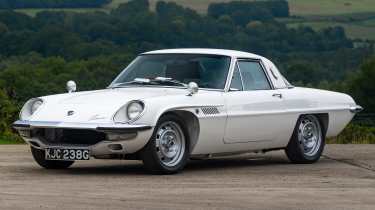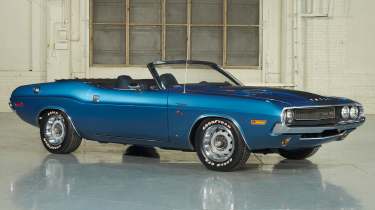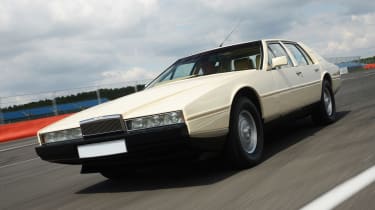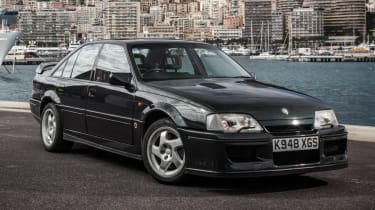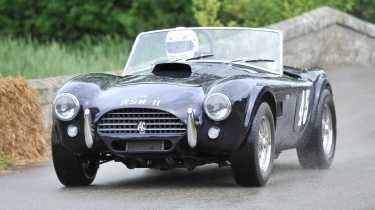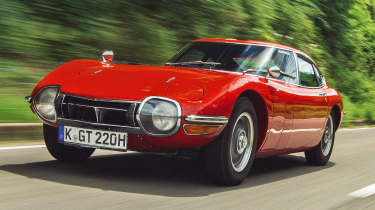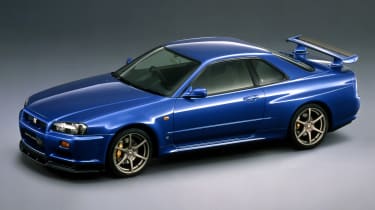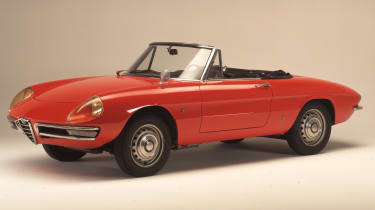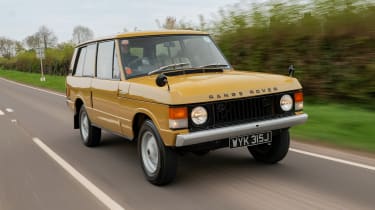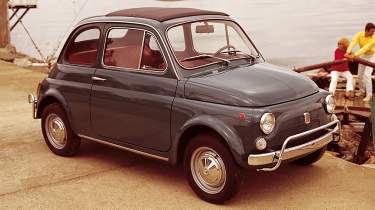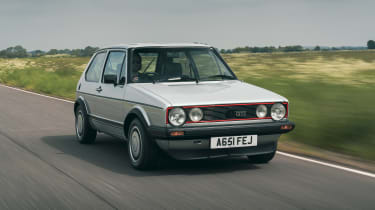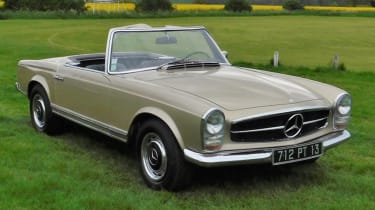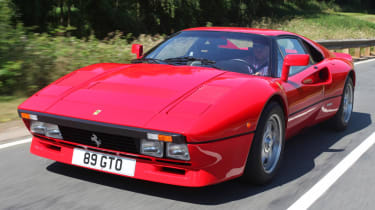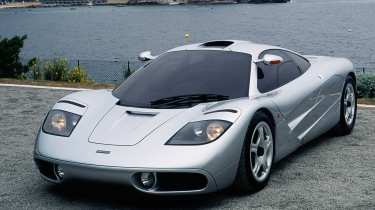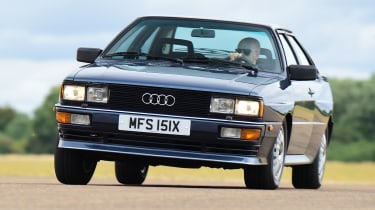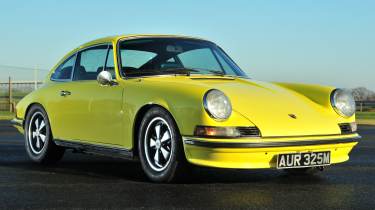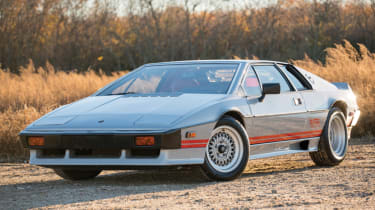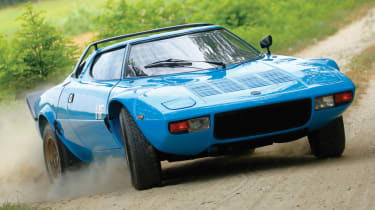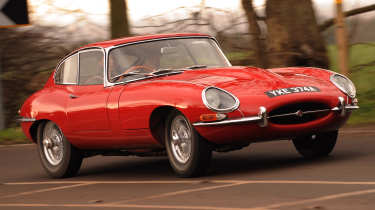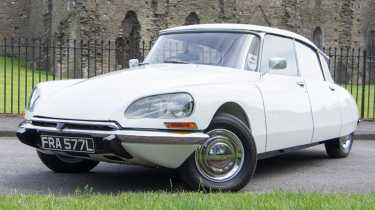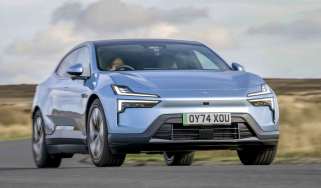Cool cars: the top 25 coolest cars in the world
Here are the top 25 coolest cars in the world according to over 6,000 of our readers
What defines cool? It’s a tough question to answer because everyone has their own way of thinking about the concept. A car that one person thinks is ultra-cool might seem boring to another. However, we can sort out some kind of consensus right here, following a cool car poll of the best-placed people in the world to work this all out: Auto Express readers.
Some cars are cool because of the association they have with the culture in a certain time period, whether that’s via appearances in movies, TV, books or even on posters. Some are cool the moment they appear thanks to brilliant design, and others are made cooler by motorsport success. There are so many reasons why a car can be cool: looks, achievements, technology and performance can all play a part.
Racing or rallying pedigree is a great way to make your car cool among fans of that particular sport, so rally fans love models driven by the top drivers to big wins. Rare cars with a short production run like the Lancia Stratos add a bit of mystique to the mix as they aren’t just motorsport successes, but also exciting to spot because you so rarely see them.
Even the name can help too. We wonder if the Shelby Cobra would be considered quite as cool without its lethal-sounding name. The McLaren F1 uses its maker’s high performance heritage to add a cool factor with its title as well.
Films are often a big part of car coolness, especially when linked with cool people like Steve McQueen. If it wasn't for the car chase in the movie Bullitt, would the Ford Mustang be as revered as it is? And surely James Bond adds a touch of cool to the cars he drives?
Certain cars are cool because they look stunning, like the Lamborghini Miura. Supercars have incredible performance and their outlandish looks support that, but going too far can make them look very uncool. There’s a fine line between a beautiful sports car and a mid-life-crisis-mobile. Ugly cars can be cool too, though, especially ones that stand out from the crowd.
So, without further ado, here are the cars that made our top 25, as voted for by over 6,000 users of Autoexpress.co.uk. Read on below to find out more about the coolest cars on sale. Finally we’ve picked out some more obscure but cool cars that you might not have heard of at the bottom of the page.
If you're looking for a cool car of your own, you can find plenty of options available via the Auto Express Buy A Car service.
Top 25 coolest cars in the world
Read below to find out which cars have been named the top 25 coolest cars..
25. Mazda Cosmo
- Years: 1967-1972
- Numbers built: 1,176
Mazda is one of the few modern-day car manufacturers that really tried using the rotary engine. While the Japanese car maker doesn’t currently have a solely rotary-powered car in its range, it is expected to bring in rotary range-extenders for electric cars at some point.
Such developments are all well and good but they are nothing to do with a small coupe that arrived in the late 1960s. The coupe in question was called the Cosmo Sport (sometimes more simply, the Cosmo) and was Mazda’s first production car to use the Felix Wankel rotary engine. The finished product was very easy on the eye and a delight to drive – the distinctive howl of the oddball engine being a particular highlight.
Being that the rotary engine is both lighter and smaller than a conventional piston engine, it lends itself very well to good weight distribution and a strong bhp per tonne ratio – both of which are important for sports cars.
Despite offering so much less than 1,200 Cosmo Sports were made and of those only a handful found owners outside of Japan. Anyone hoping to buy one now will find it difficult, especially in the UK. That said, at the time of writing two were for sale, one priced at £60,000 and the other price on application, which can often translate to eye-watering figures
24. Dodge Challenger
- Years: 1970-1974
- Number built: 165,437
The original 1970s Dodge Challenger has it all (from a muscle car point of view), although thanks to a huge number of engine and trim options some are considerably more desirable than others. Of the eight available V8 engines, it was (and still is) the 7.0-litre Hemi V8 used in R/T models that is the most muscular. It produced more than 400bhp and north of 650Nm so, despite the Challenger’s size, it promises serious performance.
When Dodge first launched the Challenger it was popular for car makers to throw all kinds of optional extras and equipment at their models – such levels of personalisation are fairly common among manufacturers today. As a result, buyers could choose from a shaker hood (which means the air intake protrudes out of the bonnet but is mounted to the engine, so it can be seen shaking when driving) and/or leather seats, vinyl stickers, leather seats, dual exhaust tips and so on.
Much like the Ford Mustang, the Challenger was available as a coupe or a convertible, although the Dodge never really enjoyed the same sales success – partly because it targeted the upper end of the pony car class so was more expensive. It also wasn’t around for that long before the 1973 oil crisis hit, which had a huge (negative) impact on gas-guzzling muscle car sales.
Some features, such as the shaker hood, were only available for select periods during the Challenger’s production run and this rarity makes them more desirable to buyers now. As a result, prices can fluctuate greatly – ranging from £30,000 to £40,000 for less desirable models in need of some TLC all the way up to £1.5 million for rare convertible Hemi R/T versions in great condition
23. Aston Martin Lagonda
- Years: 1976-1990
- Number built: 640
The 1970s Aston Martin Lagonda looks like something out of a science fiction film. It was designed by a man named William Towns and although seeing a Lagonda on the road is a rare sight indeed, the striking wedge-shaped design is instantly recognisable.
It was both massively ahead of its time and very much of its time. Production models first started arriving in 1978 and they were awash with futuristic electronics, such as touch-sensitive buttons on the dashboard. Unfortunately, some of this technology was known to have reliability troubles – which is very much period correct for some British cars.
As the Lagonda was pitched as a luxurious and comfortable saloon, it came with a suitable engine. A 5.3-litre V8 petrol unit was mated to a three-speed automatic gearbox that produced around 280bhp in early models. Series 1 and 2 models used carburettors while Series 3 and 4 versions came with more modern fuel injection. Officially, the Lagonda’s 0-60mph time is 8.8 seconds but then again, it would be terribly uncouth to even attempt as much in such a high-class automobile.
As with many iconic cars of the 20th century, the Lagonda features pop up headlights. It also came with a briefcase, which hints as to the type of affluent clientele Aston was targeting. Even now, buyers will need to be quite wealthy, as prices regularly sit around the six-figure mark
22. Vauxhall Lotus Carlton
- Years: 1990-1992
- Number built: 950
Sometimes, out of nowhere, a star is born. This is exactly what happened with the Lotus Carlton. Originally designed as a brand-building exercise between Vauxhall and Lotus, who were both then owned by General Motors, the sports saloon burst onto the scene with an outrageous top speed and acceleration that could worry even the most exotic supercars of the time.
For reference, the Carlton’s rivals from BMW and Mercedes were typically limited to 155mph, while the Vauxhall would plough on all the way to 176mph. This number was heralded as scandalous by some and there were even calls from the ‘popular’ press to restrict the top speed for safety reasons. Although far from brash, the styling was somewhat menacing, what with its flared arches, boot spoiler and dark Imperial Green (which was the only colour available from the factory).
Lotus’s involvement was far from a kiss-me-quick affair. Engineers fettled with the standard model’s 3.0-litre straight-six engine, increasing its capacity to 3.6 litres and adding two turbos – this set-up was claimed to produce 377bhp and 568Nm of torque from the factory. The suspension was also engineered to improve handling, and bigger brakes were on hand to help bring drivers back down to earth after flooring it. Grippier tyres were also used, which no doubt helped the Carlton achieve its official 0 to 60mph time of 5.0 seconds.
Only 950 units made and just 250 were UK-spec and right-hand-drive. As a result, they are a rare sight these days. That said, prices are competitive (if a little erratic) compared to the likes of the E30 M3 – think somewhere between £50,000 to £70,000. Super-low-mileage examples do occasionally pop up for in excess of £100,000, though
21. AC Cobra
- Years: 1962-1969
- Number built: 998
What do you get when you cross a red-blooded American V8 engine with a ye ole British roadster? The AC Cobra, that's what. To paint the full picture, British manufacturer AC had teamed with icon Carol Shelby to produce a car. AC would manufacture an Ace roadster (minus the engine and gearbox) ship it across the pond where Shelby would shoe-horn a Ford lump under the bonnet.
Chevrolet engines were planned to be used but it was Ford that showed the most enthusiasm. At first, Shelby used Ford’s 7.5-litre V8 but it was the 4.7-litre (or 289 cubic inch) V8 which would become the most famous engine. That said, the 7.0-litre unit later introduced to make the Cobra more competitive on the GT racing scene also grabbed attention – these models also got heavily revised suspension and a modified chassis, too. Some of the 7.0-litre models were built for racing and some for road use – the latter known as ‘427 Cobra S/Cs’ with S/C standing for ‘semi-competition’.
In truth the beautiful roadster body didn’t lend itself to high speeds from an aerodynamics point of view, so six special coupe models were commissioned with bespoke bodywork to make the cars more competitive, especially at the all-important Le Mans. Interestingly, all six still exist, despite the tax man threatening to throw some into the sea.
Shelby’s Cobra lasted until 1967, but the AC’s version (called the AC 289) lived for two years longer. Even then the Cobra wasn’t truly dead and there have been countless kits for people to build their own Cobra (using a donor car) and even pricey recreation models
20. Toyota 2000 GT
- Years: 1967-1970
- Number built: 351
Compared to a lot of the cars Japan was producing in the late 1960s Toyota’s 2000 GT is otherworldly. It is an out and out sports car and a rather good one at that. It is quite rare, too, with just 351 believed to have been built during a production run starting in 1967 and ending in 1970.
The 2000 GT is often compared to Jaguar’s E-Type, at least in coupe form, because both models come with swoopy styling and are quite well suited to grand touring. Even so, Toyota didn’t merely copy what the Brits were doing. For example, Toyota used a relatively modest 2.0-litre in-line six-cylinder engine taken from another model in its range: the Crown saloon.
Toyota didn’t design its 2000 GT all by itself, it roped in Yamaha to help spice things up a little. Improvements came in the way of an aluminium cylinder head with twin cams and Mikuni-Solex carburettors – among others. The end product was claimed to produce a modest 176Nm of torque and 148bhp. This was then fed through a five-speed manual gearbox to the rear axle, which came with a limited-slip differential. The end result was a cracking driver's car.
Like many of the coolest cars ever made, Toyota’s 2000 GT has appeared on the big screen, most notably in the 1967 James Bond film You Only Live Twice. What with their desirability you would need to be a movie star to afford a Toyota 2000 GT, although they are so rare sometimes there are none for sale. Those that have been sold in recent years (at auction) have cost between £500,000 and £700,000
19. Nissan Skyline R34
- Years: 1999-2002
- Number built: 11,578
The R34 generation of Nissan’s Skyline GT-R has been immortalised through association with films such as The Fast and the Furious and also their ability to humble much more expensive supercars on the race track. Part of this was thanks to some cutting-edge acronyms the R34 was blessed with, including ATTESA E-TS (which translates to traction control) and Super-HICAS (four-wheel steering).
Nissan’s 2.6-litre and 2.8-litre straight-six twin-turbo engines are something of a legend in car tuning circles thanks to their ability to handle significant power hikes via remaps and/or upgrades to the internals. Curiously, models were stated to come with around 276bhp from the factory but when tested their actual figures were closer to 330bhp. Surprisingly Nissan didn’t get swamped with complaints from owners.
It isn’t just the mechanicals that makes the R34 cool, it looks the part, too. The quad rear lights, spoiler and sporty body kit combine with a two-door coupe body to make one of Japan’s more recognisable cars. All this comes at quite some expense, though, with prices well in excess of £100,000.
Of those that do pop up for sale, many have been modified to some extent so there will likely be competition for any clean original examples. Changes made by owners range from full-blown race car conversions to massive exhaust tips, bigger spoilers and more aggressive styling.
Find out how the R34 stacked up to its R35 predecessor here..
18. Ford Capri
- Years: 1969-1986
- Number built: 1,900,000
While America may have had the original Mustang the UK and Europe had the Capri. In fact, the links between the two were supposed to be more obvious as Ford wanted to call its smaller sports coupe the Colt, but Mitsubishi put an end to that as they already had a model using that name.
First shown to the public in 1969, the Capri was pitched as the affordable fun coupe that could just about squeeze four people into its cabin but deliver heaps of driving fun. This formula proved so popular that almost two million models were sold during a 17-year production run.
To help keep manufacturing costs down Ford used its Cortina’s platform as a base for designing the Capri. When the finished product arrived, it came with leaf springs and drum brakes at the rear and disc brakes mounted to MacPherson struts upfront. Importantly for many drivers, a four-speed manual gearbox was also on hand.
As for engines, there were a fair few but it was (and still is) the 3.0-litre Essex V6 that stole the headlines. It produced 138bhp, which was enough for a top speed north of 100mph and while this may seem unimpressive by today's standards, lest not forget the aforementioned drum brakes and leaf spring suspension.
Back in 1968 £890 was enough to buy a Capri but nowadays you’d struggle to buy one in need of restoration for that. A budget of £5,000 just about gets a running and driving model with one of the less desirable engines (for example, the 1.3-litre petrol) but £10,000 to £15,000 will be enough to get a decent Capri with a more fruity power plant.
For more on the history of the Ford Capri, click here..
17. BMW E30 M3
- Years: 1986-1991
- Number built: 17,970
Let’s not beat around the bush, BMW’s E30 M3 is a legend. It was launched as a race car for the road, but it wasn’t a nightmare to live with because it was still a relatively practical coupe – albeit faster than most other cars on the road.
Even the regular E30 M3 looked the part but Evolution and Sport Evolutions are better still thanks to aggressive angular wheel arches. On top of the standard 3 Series, all M3s came with sporty alloy wheels, twin exhausts and a smattering of M3 badges.
It was under the body, though, that the real magic happened. At the centre of things is a 2.3-litre petrol engine that, once in the upper echelons of its rev range (5,000 to 7,000rpm), comes alive like few others. Power output is claimed to be around 200bhp but Evolution models came with an additional 15bhp. Thanks to a relatively low kerb weight of around 1,200kg an E30 M3 will go from 0-62mph in 6.7 seconds.
The handling is just as special as the engine, with corners offering drivers the chance to revel in the chassis’ balance and directness of the steering. Compared to the entertaining drive, the E30 M3’s interior is a touch boring. It is largely taken wholesale from the standard E30 3 Series, although there are some subtle touches which will make drivers feel special – such as a suede-wrapped gear lever.
Unfortunately for mere mortals, BMW’s sports coupé is so well regarded that prices are sky-high. £70,000 will just about get you a ticket to the show but the more desirable Evolution and Sport Evolution models are regularly priced well into six-figures.
Check out more on the BMW E30 M3 here..
16. Alfa Romeo Spider
- Years: 1966-1994
- Number built: 110,128
Alfa Romeo is a car manufacturer of two halves – on the one side it has been known to make some of the most beautiful cars and engines in history but on the other it has made some incredibly unreliable cars which rust quicker than you can say ‘get the dustpan and brush’.
Fortunately, the Spider is one of the Italian brand’s better efforts, although it is still wise to check for rust. Back in 1966, Alfa launched its Spider with a 1.6-litre aluminium engine that featured double overhead camshafts, a five-speed manual gearbox and disc brakes all round. While power was rated at a modest 109-ish bhp, the lightweight body and direct steering made for an enjoyable driving experience.
Even so, it wasn’t long before Alfa introduced a more powerful version – called the Spider Veloce – with a 1.8-litre engine and close to 120bhp. To help make the Spider more accessible to some, a Junior model was eventually offered with a 1.3-litre engine that produced just under 90bhp.
Although in the UK Alfa’s little roadster never reached the same sales success of the MGB, it was very popular in other countries. Its status as an Italian icon was partly helped by featuring in that classic Hollywood film, The Graduate. The Spider proved so popular, in fact, that it remained on sale for nearly 30 years, although there were four separate versions of the Italian two-seater sports car during this time.
As for prices, well, those in need of restoration start around the £10,000 to £15,000 mark and pristine models are available for north of £30,000
15. Range Rover Classic
- Years: 1970-1996
- Number built: 317,615
Few could have predicted the heights the Range Rover would reach – not least in terms of luxury and off-road prowess but also as the transport of choice for the uber-wealthy and super famous. Yet, nearly 50 years on from its launch the opulent 4x4 is still up there with the best in class.
Part of this success has been Land Rover’s drive for innovation, in fact, the original Range Rover was so innovative it created its own market segment back in the day. The very first model revealed to the world came with three doors and an interior that looked as if it could be cleaned with a hosepipe and a broom. Quite the contrast to the sleek, leather-clad versions that roll off the production line today.
Importantly, though, the Range Rover Classic was (and still is) massively comfortable and hugely capable when the going gets muddy. Such features proved all too alluring for the elite of the day and as a result it wasn’t long before the Range Rover had morphed into a luxurious five-door off-roader.
Early Range Rovers came with coil-spring suspension which blew leaf-sprung alternatives out of the water. Matching this set-up nicely were powerful V8 petrol engines and automatic gearboxes, but there were also diesel engines and manual transmissions. For many, the diesel was the one to have thanks to its ample torque for towing or climbing hillsides but also acceptable fuel economy.
Original Range Rovers continue to be popular and prices for fully restored versions (possibly modified to use a more modern engine) can exceed that of a new model. The entry point to Range Rover Classic ownership are the diesel models, with higher-mileage examples often priced below five figures.
For our review of the classic Range Rover click here..
14. Fiat 500
- Years: 1957-1975
- Number built: 3,893,294
Fiat’s 500 was Italy’s answer to those looking for a small, affordable and frugal car – in many ways it’s like a classic Mini. In fact, Fiat tried to get its little car into the original Italian Job film by offering as many as the producers could write off, but the powers that be wanted a British model to take centre stage – despite BMC (British Motor Corporation) being much less open to supplying free or even discounted cars for the film.
Irrespective of missing out on Hollywood fame, the 500 is still loved the world over, with Fiat’s newer versions continuing to sell well. Part of the original’s charm was down to its stylish exterior, dinky proportions and incredibly simple interior. Not all models were born equal, though, because the 500 L (or Lusso – meaning luxury) had a more plush cabin including a different instrument panel and seats.
The driving experience will thaw even the coldest of hearts, despite offering similar speed to a glacier. Floor the throttle and it will take over 30 seconds to get from 0 to 50mph, but then again, the 500’s two-cylinder engine that produced roughly 13bhp was never designed to set land speed records. The lack of power was a deal breaker for some, so it wasn’t long before Fiat launched a Sport model, with around 20bhp.
Prices vary wildly for a 500 today – a large part of this is the difference between those that need a complete restoration and rarer models (such as open-top ‘Jolly’ versions which are ideal for nipping to the beach) that have been completely restored. Still, a budget of £10,000 will get a decent one
13. Volkswagen Golf GTI
- Years: 1979-1984 (RHD)
- Number built: 462,000
Although not the very first hot hatch to have ever been made, Volkswagen’s Golf GTI didn’t half make a success of it. As the story goes, VW engineers decided that while the standard Golf was a good car, it really needed a little more fire in its belly. So, in their spare time (between designing normal car parts and eating bratwurst) they tweaked the styling, played with the engine and created an icon.
As many will know, the hot hatchback formula is something of a have-your-cake-and-eat-it scenario. On the one hand, the Mk1 Golf is practical (there are front and rear seats, visibility is great and there is also a relatively large boot) and affordable to run, while the performance and handling are more than enough to put a smile on many a driver’s face.
Powering the original Golf GTI is a 1.6-litre petrol engine that pumps out around 108bhp and 140Nm of torque. These numbers might seem small for a performance car, but the Mk1 GTI weighed in at only 810kg. So it would go from 0-60mph in nine seconds and hit 110mph flat out. A larger 1.8-litre engine arrived later in the Mk1’s life.
Handling is a strong point of the original Golf GTI. It was created in a time before electronic assistance/interference and super-stiff suspension became the norm for sporty hatchbacks. What’s more, the Golf GTI remains somewhat affordable (unlike some of its modern equivalents). The more expensive models cost no more than a nearly new Ford Fiesta ST (around £16,000-£17,000) but there are much more affordable versions that can be scooped up for around half of that.
Check out our test of the classic Volkswagen Golf GTI Mk1 here..
12. Mercedes-Benz 280 SL Pagoda
- Years: 1967-1971
- Number built: 23,885
When Mercedes launched its 280 SL back in the late 1960s (replacing the 250 SL) it was in an era where the most desirable cars came with ample grace and pace. Which is a lot more than can be said for some high-end cars these days.
Regardless, more than 50 years on Mercedes’ design still looks stunning despite the relatively simple (by modern standards) body shape. The geometry of the SL’s removable coupe top reminded people of East Asian temple roofs and it soon became known as the Pagoda.
Inside, it’s much the same desirable yet classy affair as the outside. The large, thin steering wheel, big round dials and subtle touches of chrome all work together to ooze sophistication. Countless famous faces have owned 280SLs, including the likes of John Lennon and Kate Moss.
All models use a six-cylinder petrol engine that sends power to the rear wheels, and while performance isn’t excessive (roughly 180bhp is on offer) it was more than enough to be one of the fastest cars on the road when launched. Speed is only half the story, though. The 280 SL was also comfortable, and thanks to some good old fashioned German engineering it could go on being comfy mile after mile without breaking down.
For the ultimate comfy sports cruiser, the rare five-speed automatics take the biscuit – although the much more common four-speed automatic still works well. Mercedes also offered a four-speed manual, which, although less popular when new than automatic transmissions, it is a peach to use.
Today the 280SL Pagoda continues to be an icon – it is basically Germany’s take on the Jaguar E-Type. Prices vary greatly depending on condition but don’t expect much change from £100,000 for your average model, while you’ll need nearer £200,000 for low-mileage top-end versions. Those hoping that the 280’s predecessors – the 250 and 230 – are significantly cheaper will be disappointed because the prices can be remarkably similar
11. Ferrari 288 GTO
- Years: 1984-1987
- Number built: 272
Fun fact: ‘GTO’ stands for Gran Turismo Omologato – the latter translating from Italian to mean homologated. This is a clue to how the 288 GTO came into existence, it was created to allow Ferrari to compete in Group B races. Not alongside Group B rally icons such as the Audi Quattro, though; it was to lock horns with the likes of Porsche’s 959 on good old-fashioned race tracks.
From the outside, Ferrari’s 288 GTO looks similar to the more run-of-the-mill (for a Ferrari, at least) 308 GTB. Despite both featuring a sleek low-slung body the two are in fact quite different. As an example, the 288 GTO had a longer wheelbase, flared wheel arches (to house bigger wheels) and a front spoiler. Perhaps the most important difference is that the 288 GTO used a tubular chassis rather than a semi-monocoque, as in the 308 GTB.
Furthermore, Ferrari blessed its 288 GTO with a cracking 2.8-litre V8 twin-turbo engine that was mounted behind the driver. The V8 was claimed to produce 400bhp and was capable of reaching 60mph from a standstill in a mere 4.9 seconds. Keep the throttle pinned and work up through the five-speed gearbox, and a 288 GTO will hit 189mph flat out. All models are believed to come with a limited-slip differential, too.
While the 288 GTO is undeniably fast, Ferrari also made ‘Evoluzione’ race-spec models, which are claimed to produce 650bhp and have a top speed of 225mph (depending on gearing). Irrespective of version, all 288 GTO models are eye-wateringly expensive with prices often surpassing two million pounds
10. McLaren F1
- Years: 1992-1998
- Number built: 106
At a time when supercars were good at going fast in a straight line, but were too lardy and cumbersome to be usable on a regular basis, designer Gordon Murray came along and blew everyone out of the water with the world's first hypercar - the McLaren F1.
Everything about the F1 is cool. The swooping bodywork, the three-seat layout, the central driving position, the massive naturally aspirated V12 in the back, and that's before we've even touched on the car's performance. Even cooler is the fact that the F1 was a road car that was converted into a racing car, but had to be restricted in its performance to give bespoke racing car rivals a fighting chance.
Murray had the idea for the F1 while working at McLaren, and convinced boss Ron Dennis that the company had to build it. At the time, McLaren had an engine supply deal with Honda for its Formula One team (hugely more successful than the most recent coupling), and it made sense for Honda to join forces for the new road car. However, Murray's demands couldn't be met by Honda, so he had to look elsewhere for the car's motive power.
Enter BMW, which supplied a 6.1-litre V12 that was built exclusively for the car and packed 618bhp, which was sent to the rear wheels via a conventional six-speed manual gearbox. The F1's compact packaging meant engine heat was a real issue, especially as the car used a carbon fibre monocoque that couldn't dissipate heat very effectively. As a result, McLaren lined the F1's engine bay with gold, one of the most efficient heat reflectors available.
Elsewhere, Murray wanted the F1 to deliver great handling, yet still be comfortable enough to use on a regular basis. As a result, the F1 has a relatively soft suspension set-up for cruising comfort, but it delivers outstanding grip and roadholding for the time. Bespoke tyres were developed for the car, while a pair of fans under the car helped create downforce in the absence of any wings or spoilers on the car's bodywork - the only concession to body aerodynamics is a pop-up rear spoiler that deploys under heavy braking. All of this, combined with a kerbweight of just over a tone, resulted in a car that delivered nimble handling that hadn't been seen from a high-performance supercar in a number of years.
But the defining feature of the McLaren F1 when it launched was its performance figures. While rivals from Ferrari and Lamborghini were only just cresting the 200mph barrier, the F1 smashed it by recording a top speed of 240mph. Even today, only a handful of cars from makers such as Bugatti, Koenigsegg and Pagani can better the F1, and all of these use turbos to boost their performance. From a standing start, the F1 is equally impressive, with 0-60mph taking 3.2 seconds, and 0-100mph in 6.3 seconds.
There's no doubt that the McLaren F1 remains the epitome of cool. Its exclusivity and entirely bespoke nature mean it will always be the hypercar that all others will be judged against
9. Audi Quattro
- Years: 1980-1991
- Number built: 11,500
The Audi Quattro is the second dedicated rally car in our list, so it's clear that there's extra cool points to be earned from competing on these tough events. Where the Ur-Quattro (the name means original Quattro, and is designed to differentiate the coupe from Audi's quattro-equipped cars) differs from the Lancia Stratos is that it employed new technology to take advantage of new motorsport rules that allowed the use of four-wheel-drive cars.
The initial idea for the Quattro came from an Audi engineer who saw that a slow and lumbering VW Iltis jeep with four-wheel drive was far better at driving in the snow than any other car, no matter how much power the other car had. So engineers joined forces and developed a 4WD mule based on the Audi 80 saloon to see exactly what would happen in a car equipped with the Iltis' running gear. Soon, the Quattro was born, with a 197bhp five-cylinder turbocharged engine and flared wheelarches designed to mark it out from the standard Audi Coupe on which it was based.
It only seemed natural to take the Quattro racing, and it soon came to dominate rallies across the globe against its two-wheel-drive opponents. The Quattro won the World Rally Championship in 1982 with Michele Mouton, and again in 1984 with Stig Blomqvist. It took 23 rally victories between 1981-1985, but by the time of the last of these, the Quattro was getting outgunned by faster cars like the Lancia Delta S4 and Peugeot 205 T16.
As a result, Audi attempted to reinvent the Quattro for the Group B era. First was the short wheelbase Sport Quattro that chopped a foot out of the car's wheelbase to give it sharper handling. Then came the Quattro S1 E2 with wider arches, huge wings and up to 500bhp, but it was too late to give the Quattro the winning advantage against its rivals. And with the banning of Group B machines in 1986, Audi's participation in front-line WRC events came to an end.
Still, the Quattro's reputation had been established, and while road car production only amounted to just over 11,000 cars, it's now a bona-fide classic with auction values reflecting its cult status. The Quattro also went on to establish Audi's performance car division, while the quattro tag is used on any four-wheel-drive Audi on sale.
Successors to the Quattro initially copied its 4WD, five-cylinder turbo layout, with models like the Coupe S2 and RS2 Avant also gaining cult status. In later years, five-cylinder power made way for V6, V8 and even V10 power for Audi's S and RS models, but the launch of the most recent Audi TT RS and RS3 Sportback saw the revival of the five-cylinder turbo and its classic warbling soundtrack. The spirit of the Quattro lives on
8. Porsche 911
- Years: 1963-1989
- Number built: 311,000
Few cars deliver the kind of cool factor that the Porsche 911 can, which is part of the reason why it has evolved into the car that's on sale today, while outlasting its contemporaries and the models designed to replace it. The rear-engine layout gave the original 911 a reputation for tricky handling, and there is nothing cooler than seeing an original 911 being hustled along a twisty road by a driver that knows how to deal with the limits of the car's handling. Add-in its numerous racing and rally successes, and a host of celebrity owners, and the 911's place on our list is cemented.
The original Porsche 911 was the replacement for the ageing VW Beetle-based 356, but initially it wasn't even known as the 911. A trademark dispute with Peugeot, which claimed it had the rights to numbering cars in three digits with a zero in the middle, saw the original 901 name switched to 911, and a legend was born, although the handful of 901-badged '911s' that were sold before the name change are among the most collectable versions of all.
What the 911 carried over from the 356 was its rear-engined layout and air-cooled engine, although it had grown to 2.0-litres and 128bhp. That wasn't too much to get into trouble, but power soon increased with subsequent 911S, Carrera and 2.7-litre flat-six models.
Among the most collectable of these models is the Carrera RS. RS stands for Rennsport, 'racing sport' in German, and was a special model designed to qualify the 911 for competition. Over the years, the 911 spawned a host of competition variants, and one of the most successful was the 935. This was arguably the pinnacle of the 911's racing heritage, as it even won the Le Mans 24 Hours outright in 1979.
That competition history established the 911 as the roadgoing sports car of choice for people who enjoyed driving, while the flat-six engine could be directly associated with Porsche's motorsport success. That can be even more closely associated with the later 911 Turbo of 1974. This was the car, internally known as the Porsche 930, which cemented the 911's status as a tricky car to handle. Easily identified by the big rear wing on the back, the 911 Turbo featured up to 300bhp, but that rear-engined layout and the delayed power delivery as the turbocharger kicked in meant the unwary could find the rear end of the car catching up with the front all too quickly.
Still, this seemed to build on the 911's reputation, and while Porsche introduced the front-engined 928 as a replacement for the 911, buyers still wanted the original machine. So the 911 evolved in 1989 into the 964, which updated the looks, and the 993 in 1994, which featured a new chassis and a more modern interior. Then came the water-cooled 996, 997 and current 991 series, and while these cars moved further away from the original concept, they all still wear the 911 badge with pride, and look and drive unlike any other sports car on sale today
7. Lotus Esprit
- Years: 1976-2004
- Number built: 10,675
One sure-fire way to earn cool status is to be cast alongside James Bond in the 007 movies. In fact, the Lotus Esprit was cool enough to appear in two movies, and this was well before the days when product placement meant you could buy your way on to the silver screen (hello Ford!).
Sure, the Aston Martin DB5 from Goldfinger is the more famous Bond car, and is synonymous with Britain's most famous secret agent, but that's the obvious choice, so it's not as inherently cool as the Esprit. And besides, the DB5 didn't turn into a submarine at the push of a button…
There was much more to the Esprit than simply being spy transport. Its wedge shape was pure concept car, the work of Italian styling master Giorgetto Giugiaro, with a low-slung body and typical mid-engined supercar layout. Unfortunately, that engine bay only housed a 162bhp 2.0-litre four-cylinder engine, although the later Esprit Turbo did redeem itself somewhat with 211bhp, and finally 217bhp in Turbo HC guise.
A redesign in 1987 saw Giuigaro's decidedly retro-looking wedge replaced by a curvier body designed by Peter Stevens. Four-cylinder power remained, while the Esprit's parts-bin character only added to its coolness. Look closer, and you'd find door handles from the Austin Allegro and then the Vauxhall Calibra were used, the side mirrors were from the Citroen CX, and the tail-lights were the same as the Fiat X1/9, and later the Rover SD1. There were more scavenged parts under the skin, and over time the Esprit used a Citroen gearbox, a Vauxhall Omega alternator, Opel Ascona suspension parts, and the fuel pump from a Renault Fuego.
One aspect of the Esprit that stuck true to other Lotus models like the Elan and Seven was its commitment to light weight. The steel frame chassis was clothed in lightweight fibreglass bodywork, while the small engine meant overall kerb-weight was reined-in to under a tonne - about the same as a Ford Escort of the time, but with more than twice the power.
It was only towards the end of its life that the Esprit got the engine it deserved, as the Esprit V8 was a direct result of the car's competition appearance in the fledgling GT1 sports car championship. This 500bhp 3.5-litre twin-turbo V8 was more like the kind of motor you'd find in a Ferrari than a Ford, as its flat-plane crank meant it screamed rather than rumbled, and it gave the Esprit a 0-62mph time of 4.3 seconds.
By the time production of the Esprit came to a halt in 2004, it had become an established supercar, although low sales volumes have ensured its exclusivity. As for a successor to the Esprit, well, we're still waiting. Lotus has stumbled from pillar to post with different owners and financial difficulties, but with the demand for exclusive supercars showing no signs of waning, and new ownership of parent firm Proton by Chinese maker Geely, it can only be a matter of time before an all-new Esprit hits a motor show stand. Who knows, it could even be cast as Bond's next company car..
6. Mini
- Years: 1959-2000
- Number built: 5.4 million
The Swinging Sixties were a particularly cool time in the UK, and the Mini was the car to be seen in. Its compact dimensions and bright colours meant it stood out in a new car market that was populated by upright and stuffy saloons, and it proved a hit with city dwellers thanks to its great combination of small size and a surprisingly roomy interior. Add-in an A-list cast of Sixties stars that drove Minis, including The Beatles, Peter Sellers, Princess Margaret and even racer Graham Hill, and the Mini quickly gained cool status without much effort.
The car was the brainchild of Sir Alec Issigonis, and its compact front-engine, front-wheel-drive layout was innovative at the time. Putting all of the mechanical parts at one end of the car meant there was plenty of space left for passengers and some luggage, and it meant the Mini could be a lot smaller than other cars on sale at the time.
Initially it went on sale as the Morris Mini and the Austin Seven - the latter name being a blast from Austin's past, although it was changed to Austin Mini in 1962. It also spawned a number of variants under the British Motor Corporation (BMC), including the Wolseley Hornet and Riley Elf saloons and the Mini Moke buggy-type machine. It was built under licence by Italian company Innocenti, as well as Leyland in Australia and sold as kits in South America.
The Mini was never a fast car, although that didn't stop the introduction of the Mini Cooper and Cooper S. These proto-hot hatchbacks were tweaked versions created by John Cooper's racing team, and the Cooper S proved particularly adept at giant-killing feats on the rallying and touring car stages.
The Mini Cooper won the gruelling Monte Carlo rally three times (four, if you count its controversial disqualification in 1966), and the sight of a tiny Mini doing battle with giant Camaro and Mustang muscle cars in the British Touring Car Championship, using its higher cornering speeds to great effect, became a regular sight at race tracks across the UK.
Some would argue that the Mini spent too long in production, and its heyday in the Swinging Sixties was almost obscured by its part in the malaise that was the British car industry of the 1970s.
But the Mini simply wouldn't die. The arrival of the Metro in 1980 was supposed to signal the death knell for Issigonis's creation, but it came and went, and the Mini was still being built when the Metro, by then called the Rover 100, was but to seed in 1998.
By the time the Mini finally stopped production in 2000, it had regained some of the verve that made it so popular in the first place. It can lay claim to its place in our cool list, thanks to its innovative ideas that remain a cornerstone for nearly every small car on sale today
5. Lamborghini Miura
- Years: 1966-73
- Number built: 764
By laying claim to the title of being the first mid-engined supercar, the Lamborghini Miura is instantly cool. That curvy, low-slung body was the work of Marcello Gandini of Bertone (like the Lancia Stratos in this list), and it's wrapped around a monstrous V12 that set the template for all future Lamborghinis.
The Miura wasn't Lamborghini's first car, that title is claimed by the front-engined, rear-drive 350GT, but it made more waves than the 350GT when it was announced. The first anybody knew about it was when Lambo revealed its P400 chassis at the 1965 Turin motor show, which showed the car's compact dimensions and new transverse mid-engine layout. That was enough for some buyers to put down a deposit there and then, before the bodywork had even been designed, but they certainly wouldn't have been disappointed with Gandini's design when it was finally revealed.
That V12 initially packed 345bhp, while later SV models had 380bhp. Combined with the Miura's modest size, that gave it sub-seven second 0-60mph times, and a top speed in excess of 170mph was easily achievable. Surprisingly, the Miura shares something in common with another car in our list, because it and the Mini both had integrated engine and gearbox assemblies. That meant the engine and gearbox used the same oil, which might have been a great cost-saving exercise in the Mini, but it was a concept abandoned by Lambo by the time the more powerful Miura SV arrived.
Like with other cars in this list, a dose of celebrity endorsement helped raise the Miura's cool factor. Frank Sinatra owned one, while jazz musician Miles Davis also drove one, until he crashed it, breaking both ankles in the process. Perhaps the most famous Miura is the one featured at the start of the movie The Italian Job. The film starts with a Miura being driven through the Italian Alps before being unceremoniously destroyed by the Mafia with a bulldozer. However, not all is as it seems with this clip, because while a Miura was pushed off a cliff, it was one that had already been crashed - the first car remained intact and was sold on after filming.
Another first for the Miura was the addition of Lamborghini's bull badge. The Miura name comes from a Spanish bull breeder, and company boss Ferrucio Lamborghini felt the bull was a good fit for his company, especially as his star sign was Taurus.
The Miura is a genuine supercar classic. Its V12 powerplant laid the foundations for the Countach, Diablo and Murcielago, while the stir its design caused taught the firm that a sensational look would always win buyers over
4. Land Rover Defender
- Years: 1948-2016
- Number built: Loads
Few cars have survived for as long as the original Land Rover did. While the last Defender is what we've named it in the list, we're counting the entire heritage of the car, all the way back to the 1948 original. In terms of history and longevity, only the Jeep and Mercedes G-Wagen can compete, but the former has evolved beyond recognition from the Willys original, while the latter is now a fashion trinket for the rich. In comparison, the Land Rover is fairly unique in the breadth of its abilities.
That's what makes it especially cool, because the Land Rover looks equally at home on the farm or in the city. Defenders have been used for all kinds of jobs, from remote Scottish farms to Home Counties building sites, as airport as fire engines, to tow boats for the coastguard and even in battle. The Defender really is the Swiss Army knife of utilitarian transportation.
The simplicity of the Defender is one of its plus points. There are no luxuries here, just seats, a heater, maybe a radio, and windows to keep the weather off, but that's just about it. Sure, you can spec up a Defender at an aftermarket conversion company so it's as plush as a G-Wagen, but you can be just as smart cruising the King's Road in a standard short-wheelbase XS model if you want to be seen.
What people won't be aware of is exactly how much of a struggle it is to drive a Defender. While they may look good from the outside, it's a different experience altogether from behind the wheel. Heavy steering, a massive turning circle, a cramped driving position, wooden brakes, a heavy clutch and relaxed acceleration mean the Defender is from another era in terms of driving. Still, some people will enjoy the challenge of driving one, even more so if they take it off-road.
The Defender is next to unstoppable in the rough. The short wheelbase version is the one to go for, and its short overhangs and narrow body mean it'll get well off the beaten track without getting stuck. And there are plenty of aftermarket specialists who can kit a Defender out in all sorts of equipment to make it even more even capable when the going gets muddy.
If you're not a fan of the new Defender's contemporary, refined design, you might be tempted to buy a Defender and our advice is to go for as late a model as possible. The best diesel engine is the last one, which is the 2.2-litre Duratorq from the Ford Transit. It's not outstandingly powerful, but is good enough, and is the most refined engine, too. If you can afford it, we'd recommend one of the limited edition final run cars, too. The Heritage Edition harks back to the 1948 original with its green paint and tan interior, while the Adventure gets a host of off-road upgrades. The Autobiography is the highest spec Defender there has ever been, although with a list price of £61,000, it was also the most expensive
3. Lancia Stratos
- Years: 1973-1978
- Number built: 492
What's cooler than building a car that looks like a concept car to go rallying in? Not much, and that's exactly what Lancia did when it introduced the Stratos. It was the replacement for the successful Fulvia HF, but rather than evolve that front-engine, front-drive coupe, Lancia went mad and produced a stunning wedge of a car with a mid-mounted engine sourced from Ferrari. Can you think of anything cooler than something as radical as the Stratos storming down a forest track, flames spitting from its exhaust? That's what makes this a cool car.
The Stratos name originally appeared on a Lancia concept car seen in 1970, but the only thing that car and the rally Stratos have in common is the fact they were both designed by Marcello Gandini, the head designer at Bertone. The rally machine was preceded by the Stratos HF concept of 1971. This previewed the new car's radical shape and really stood out, and not just because it was painted fluorescent orange. Its wedge-shaped design and tiny cockpit area with next to no rearward visibility meant it looked like nothing else, and definitely not like a rally car.
However, that was the purpose of the Stratos, and to underline the point Lancia fitted it with the 2.4-litre V6 from the Ferrari Dino. This made 190bhp in 'Stradale' roadgoing spec, and Lancia was scheduled to build 500 cars to meet rallying regulations of the time.
However, changes to the rules meant that only 492 were eventually made. Later cars came with a more powerful engine with 24-valve heads, compared to the original car's 12-valve configuration, and packed 320bhp. Combine this power with the car's lightweight and short wheelbase, and the Stratos proved nimble, if not a little twitchy at the limit of its capabilities.
The Lancia Stratos was one of the first cars to be built specifically to be competitive in rallying, and came almost a decade before the notorious Group B era. And it proved to be hugely successful, too, winning the World Rally Championship three years in a row from 1974-1976, and it was still winning rallies in the early 1980s. The rule makers tried to peg the Stratos back by limiting its performance, but the road car had a kerb weight under a tonne, and the rally cars were lighter still.
With such little weight for that Dino V6 to push along, it remained a competitive car for many years. Lancia even converted two examples for endurance racing by strapping a big turbo to the engine to break the 500bhp barrier and fitting massive wings, although neither car was very successful.
The Stratos has gone down in history as the radical rally car, but it set the template for Lancia's next forays into the world of rallying. The Lancia Rally 037 followed it in 1982 with a similar mid-engine, rear-drive layout, although it replaced the V6 with a turbo four. Then the wild Delta S4 added four-wheel drive to the mix, a turbo and supercharged engine and bodywork that was barely recognisable from the road-going Delta
2. Jaguar E-Type
- Years: 1961-1975
- Number built: 73,000 (approx)
If Enzo Ferrari says that your car is 'the most beautiful car ever made' then you must be doing something right. That was his remark when he saw the Jaguar E-Type at the 1961 Geneva Motor Show, which is where Jaguar revealed its new sports car for the first time. The Malcolm Sayer-penned design is as distinctive today as it was when the E-Type was first revealed, with the curved nose, long bonnet and taut rear end giving it a unique look that is clearly as cool as sports cars get.
The E-Type name was a continuation from the C-Type and D-Type racing cars that won the Le Mans 24 Hours in the 1950s, and it shared plenty of technology with the latter of these. A monocoque construction, with the body and engine bolted directly to the frame, disc brakes, fully independent suspension and direct rack-and-pinion steering was all taken from the D-Type, and set new standards for race car technology on the road.
Even better was the use of a 3.8-litre version of Jag's potent XK straight-six engine. This 265bhp unit gave the E-Type a claimed top speed of 150mph, but while this was verified by magazines of the time, the cars tested had been gently fettled by Jag to achieve these speeds. The introduction of a 4.2-litre E-Type in 1964 gave better mid-range torque while still maintaining a 150mph top speed.
What was more appealing about the E-Type was its sheer value for money. It came in at a price that was a fraction of the Ferraris and Aston Martins of the time that had similar performance, and as a result these makers had to rethink their strategies when it came to the kind of performance-per-pound that they offered.
The E-Type was produced for 14 years in total, but while the 1961 original wowed the crowds, some would argue that things went downhill from there. The smooth lines of the original Series 1 E-Type were slightly spoiled by the removal of the headlight covers - an essential update to improve visibility at night - while the arrival of the Series 2 in 1968 saw the E-Type strangulated by US emissions laws. The straight-six had its power cut by 20bhp, while some of the interior trim was downgraded, too. The arrival of a 2+2 also saw a longer body used that didn't look quite as elegant as its two-seater counterparts.
Then in 1971, the Series 3 transformed the E-Type from sports car to grand tourer, with the addition of Jag's mammoth 5.3-litre V12. This car had a quoted top speed of 135mph, but it also had awkward looks, with big bumpers and alloy wheels replacing the wire wheels on earlier cars.
Still, rewind to the original E, and you do have a seriously cool car. Even cooler are the lightweight E-Type Low-Drag coupes. These competition-focused models used plenty of aluminium in their construction, and were a logical evolution of the D-Type. While they didn't win Le Mans, the 12 cars built did reasonably well with private owners. And Jag saw fit to reintroduce the lightweight in 2014, with the intention to build the six remaining cars that were supposed to be built alongside the first dozen. While they may lack the heritage of the originals, the 'new' lightweights will set you back well over £1million - if you can find one in the first place
1. Citroen DS
- Years: 1955-1975
- Number built: 1.46million
According to our readers, if there's one car that is the absolute epitome of cool, it's the Citroen DS. It's not the fastest or the most exclusive car in our list, but it certainly has style and clever engineering on its side, while the DS name is a play on the French word for Goddess (déesse). You can easily envisage the DS wafting serenely around Paris, along the Champs Elysee and around the Arc De Triomphe before parking up in front of a cafe in the city.
When the DS was revealed at the Paris Motor Show in 1955, its slippery shape wowed the crowds, and Citroen took nearly 20,000 orders for the car on its first day on display. It became a symbol of French innovation, thanks to advanced hydropneumatic suspension that included a self-levelling function that allowed the DS to deliver a comfortable ride on even the rough roads that were common in France at the time. The suspension could also be raised or lowered, while the pressure in the system drops when the engine is switched off, lowering the DS to the ground in that distinctive way that's such a familiar trait of the car.
The innovations didn't end with the suspension, as disc brakes, power steering and a hydraulically-controlled four-speed manual gearbox with no clutch pedal also featured on the DS. A fibreglass roof helped save weight, while a wide front track compared with that at the rear boosted the front-wheel-drive DS's handling.
Throughout its life, the DS had a number of innovations added, including directional headlamps that turned by up to 80 degrees in line with the steering. Self-levelling headlights were also added to cope with changes in the car's pitch when accelerating and braking.
One area where the DS was a little backward was its engine, because the original car used a development of the four-cylinder unit found in the Traction Avant, which the DS replaced. That engine could trace its roots to the 1930s, and was used after Citroen had abandoned plans to fit the DS with a new air-cooled flat-six. The DS never really had the power to match some executive car rivals, thanks to France's taxation rules, but the addition of fuel injection and bigger engines over its life cycle helped matters. Having said that, the most powerful DS23 still only had 141bhp.
As well as a four-door saloon, the DS was also sold as a Safari estate, and there were convertible versions offered, too. The DS proved popular with French heads of state - President Charles De Gaulle praised the DS after an assassination attempt on him failed because the standard DS he was riding in managed to escape danger, despite being riddled with bullet holes. But the DS also gained popularity as a taxi in France, while success on rallies such as the Monte Carlo and marathon events like the London-Sydney rally demonstrated the car's reliability.
The DS remained in production for 20 years, unheard of in these days of five-year life cycles, and nearly 1.5 million were made in that time. It left a legacy that saw Citroen launch DS as a separate luxury brand in 2010, while the original DS is now a sought-after classic that commands a premium at auctions across the globe - it was even voted the most beautiful car of all time in a poll of 20 leading car designers.
And of course, the car's appearance in popular culture has cemented its place as the coolest car ever. Celebrity owners included cosmonaut Yuri Gagarin and artist Marc Chagall, while movie appearances include as a flying taxi in Back To The Future Part 2, where it picked up passengers in 2015, 60 years after it was first revealed...
Top 25 coolest cars
Coolest cars: obscure but cool
Our original poll covered the top 25 coolest cars according to popular opinion, and we reckon it’s a pretty definitive list. However, the nature of public polls means that some ultra-cool cars that not everyone has heard of will never make the cut. So here are five of the coolest cars you might not even know existed.
Honda S600
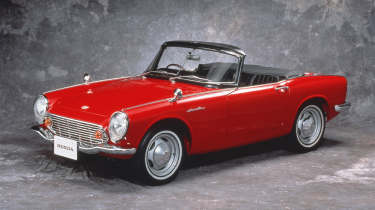
Honda isn’t a particularly cool brand. Its most famous models like the Civic and Accord are pretty dull family cars, and the boy-racer image of the Type R models means rather few people would think they are cool. You’d be hard-pressed to find anyone who doesn’t like the dainty, beautiful and unique S600 (and later S800).
This 1960s mini-masterpiece looks just as good as western equivalent two-seater sports cars of the era but it does so with absolutely tiny proportions. It ticks the enthusiast boxes too with its tiny 600cc four-cylinder engine that revs to over 8,000rpm!
Alpina B12 5.0
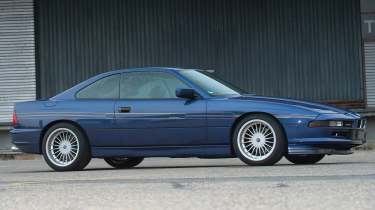
Alpina makes a lot of cool cars if you like the idea of something special, well-engineered and high-performance in a relatively normal-looking package. Only those in the know will spot an Alpina, as most will think it’s just another BMW. However, the Alpina we’ve picked here bucks that trend simply because it’s based on the BMW 8 Series, already a cool car in its own right.
The Alpina version is called the B12 5.0 (there was also a 5.7 version with a larger engine) and is exceedingly rare, brilliant to drive and looks stunning thanks to the subtle tweaks applied by the German tuner.
Autozam AZ-1
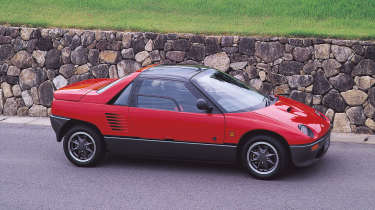
The Autozam AZ-1 is probably one of the more famous obscure cars, but that’s because there are a lot of people out there who think it’s very cool indeed. It’s a kei car made by Mazda - Kei cars being a Japanese classification for tiny cars under a certain size and with a 660cc engine - yet it has all the hallmarks of a supercar.
It’s mid-engined and even has gull-wing doors. Along with the Honda Beat - another cool kei car from the 1990s - it’s a favourite of Japanese car fans and proves you don’t need big performance to have something very cool and fun.
HSV Maloo
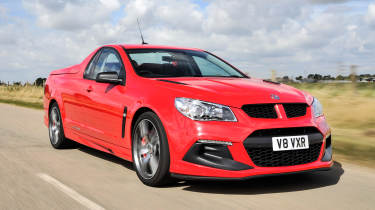
Car fans from around the world might not know about the HSV Maloo, but Australian ones will certainly know about it. It’s a ute - short for utility (or pickup truck to the rest of us) - with a long, practical load bay. Yet under the bonnet there’s the engine from a Corvette that delivers astonishing performance and an amazing soundtrack.
It’s what Aussie cars are known for, all summed up in one package: loud, fast and fun but also practical and affordable. The over-the-top looks from the front perhaps detract from the cool factor, but ask any car enthusiast what the coolest pickup ever is and the Maloo will have to be in the list.
Lister Storm
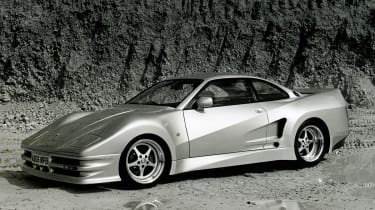
Here’s one for fans of Le Mans racing - or just the Gran Turismo games, as the Lister Storm was featured early on in the series and won over a lot of young fans in doing so. The Storm was developed as a race car for the GT1 class at Le Mans but also as a road car - a surefire route to being cool, as homologation specials are usually loved by car fans. Just look at the Ford RS200 and Renault 5 Turbo for some more examples.
The Lister Storm is our pick simply because it’s a lesser-known example from a British firm and it uses a ridiculous 7.0-litre V12 engine packed into a unique chassis designed for the race track - yet it still had four seats and was road-legal.
Buick GNX
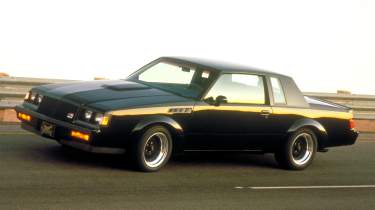
American car fans will certainly know about the Buick GNX. It was based on the Buick Regal Grand National, itself a performance version of a very ordinary family car. The GNX (which stood for Grand National Experimental) turned up the wick with a big turbocharger for the V6 engine. It was rather different from similar American cars of the era, which tended to use naturally-aspirated V8 power, but the GNX had strong performance for its day.
What made it cool was the black-on-black paintwork and wheels, which combined with the boxy bodywork to create the ultimate 80s muscle car. If that doesn’t convince you, how about the fact that Kendrick Lamar used it for the title - and cover image - of his 2024 album?
Tell us about any cool cars you think were overlooked in the comments section below…



